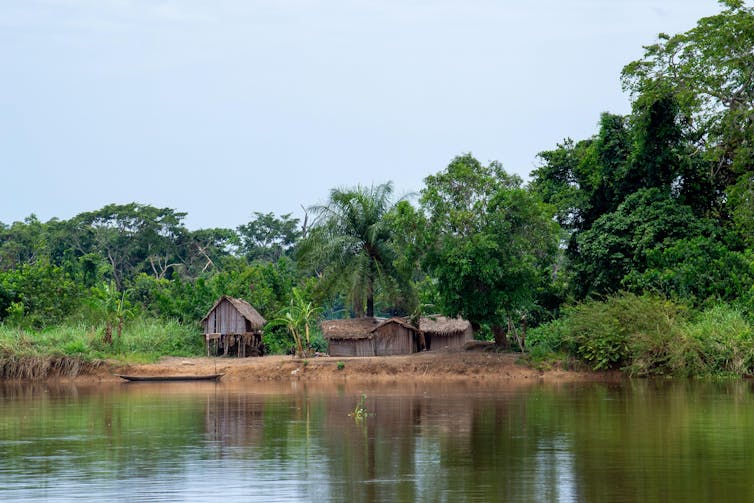Perilously situated between rising sea levels and pressures from upstream lie coastal river deltas and their roughly half a billion inhabitants. These regions have played an important role in societal development since the last ice age, offering flat, fertile lands with abundant freshwater which are ideal for agriculture.
In recent times, coastal river deltas have become hubs of the global shipping trade, giving rise to fast-growing megacities such as Dhaka, Cairo and Shanghai. But these areas are now under threat. And not all of the blame can be placed on climate change.
Our recent research reveals that 49 deltas around the world, including the Nile, Mekong, and Mississippi are facing growing risks under all of the IPCC’s future scenarios for climate change and development.
Our analysis shows that certain risks are more critical to some deltas than others. These risks include land subsidence, increasing population density, intensive agriculture, ineffective governance and a lack of capacity to adapt.

Sinking land
Sea level rise and its associated impacts, such as salinisation, are a key threat to deltas. But it’s not just the rising sea that creates such risks – deltas themselves are sinking. Our results show that land subsides as much as three times faster than sea level rise in deltas such as the Mekong in Vietnam and the Krishna and Godavari in India.
All land rises and falls as the Earth’s crust slowly changes shape. But, when land consists of a sediment pile hundreds of metres deep, as in some deltas, the process can happen much faster. The sediment particles compact together under the weight of everything on top (including cities), and when the water, or sometimes oil and gas, that naturally fills the spaces between particles is pumped out, the grains collapse on top of each other.
Land subsidence leads to relative sea level rise (the combination of the sea level rising plus the land sinking). This process can turn croplands salty, cause widespread flooding and, in extreme cases, lead to the loss of entire coastal areas. Research suggests that around 25% of the Indonesian capital Jakarta, which is built on low-lying land next to the sea, will be submerged in 2050.
Population density and crop land use
The Nile, Ganges and Pearl deltas are also among the most densely populated places in the world. China’s Pearl delta, in particular, is jammed with the megacities of Guangzhou, Dongguan and Foshan, which are together home to over 30 million people. Many deltas will become even more densely populated and urbanised over the coming decades.
Urban development prevents natural river flooding processes from delivering sediment to deltas and maintaining the land’s elevation above the river channel and sea. This can cause delta land to sink relative to sea level at an even faster pace.
Deltas are also hugely important for food production. Irrigated agriculture occupies almost all of the Red delta in Vietnam, the Po in Italy and the Yangtze in China. If groundwater is pumped from aquifers to irrigate crops, then again these deltas will subside much faster.
Disrupted food production in these places could have dire consequences in the future – and not just for delta inhabitants. Vietnam is the world’s second-largest rice exporter and almost all of that rice comes from the Mekong delta.

Capacity to adapt
Delta countries have options when it comes to managing many of the risks they face – they are not simply at the mercy of large global greenhouse gas emitters. However, the readiness, capacity and effectiveness of governments to adapt to risks is low in many deltas.
This is particularly true for the Irrawaddy delta in Myanmar and African deltas including the Congo, Limpopo and Zambezi. The per capita GDP of the countries in these deltas is among the lowest in the world, as are indicators of government effectiveness and readiness for adaptation.
International support and cooperation can and should play a supportive role here. But this is no simple task. Developing countries require a substantial amount of funding to implement necessary adaptation measures. In fact, the adaption finance needs of developing countries are now ten to 18 times as big as international public finance flows (funds that move between countries typically with the aim of supporting development).
And that’s just for adapting to climate change. The array of delta risks revealed by our analysis stretch far beyond the climate and require coordination from local to global scales.

What’s the solution?
Solutions must be developed that consider all of these risks. Efforts to limit climate change remain urgent, as does the regulation of groundwater and fossil fuel extraction from deltas.
Cities can be designed to be more resilient against floods, while agricultural practices can be adapted to cope with risks. This may involve embracing methods such as aquaculture, cultivating salt-tolerant crops, or exploring alternative farming approaches that can accommodate flooding and delta sedimentation processes.
Read more: Climate change is making soils saltier, forcing many farmers to find new livelihoods
Engineered solutions, such as sea walls, will be required where other strategies are impossible. But these should not become the default approach. Above all, the development of solutions must be inclusive, involving not only experts but also local people, propelled by urgently needed government action and finance.

Don’t have time to read about climate change as much as you’d like?
Get a weekly roundup in your inbox instead. Every Wednesday, The Conversation’s environment editor writes Imagine, a short email that goes a little deeper into just one climate issue. Join the 20,000+ readers who’ve subscribed so far.

